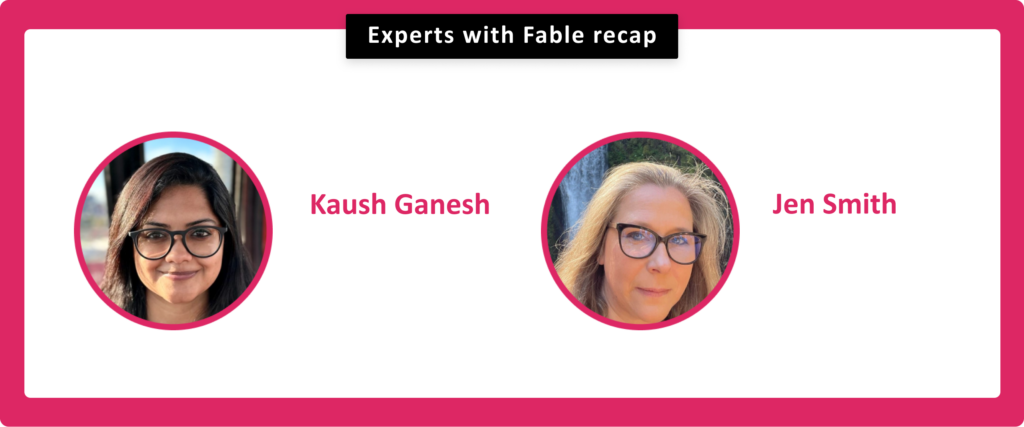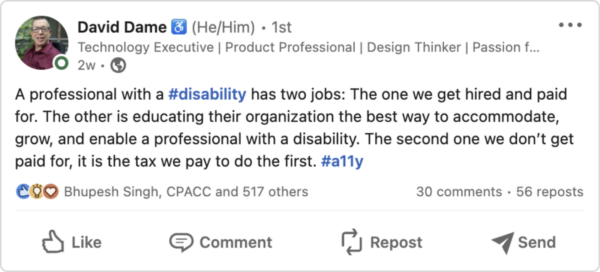
3 tips for building an accessibility program from accessibility research experts at Duo Security and Visa
Experts with Fable recap: How to build an accessibility champion program at your organization
Experts with Fable is an ongoing webinar series where UX designers, researchers, product managers, engineers and accessibility professionals from leading companies discuss their digital accessibility projects, lessons, and strategies. To stay in the loop about future Experts with Fable, follow us on LinkedIn and Twitter.
In our latest edition of Experts with Fable, Amber Knabl, CPACC, Accessibility Strategy and Enablement Lead at Fable, sat down with Kaush Ganesh, Senior Design Researcher of Duo Security at Cisco, and Jen Smith, PCWA, Design Director of Accessibility at Visa to discuss learnings from their experiences building accessibility champion programs. This blog will cover:
- The top three tips for building an accessibility (a11y) champions program
- How to meaningfully include people with disabilities in your efforts
“What we have are a few people who know a lot about accessibility. What we need are a lot of people to know a little about it.”
– Matt May, Head of Inclusive Design at Adobe
There are endless benefits to creating an accessibility champions program. As an industry, we know that we need a shared sense of responsibility from all teams to build the best and most inclusive products. When you bring together a dedicated group of like-minded, driven individuals it can help any accessibility program scale exponentially. That said, many don’t know where, when or how to start when the need arises. The good news is you don’t need to re-invent the wheel.
1. Start small
When you decide you want to start an a11y champions program, it can be easy to get caught up in the details. You may feel like you have to have all of your long-term goals and key performance indicators (KPIs) for your program in permanent marker.
Things like structure, meeting frequency, goals, and even a name can pull you away from what matters most – making your time and expertise accessible to others around you. Whether you decide to name your initiative a champions program, a group or a guild, the most important efforts are the first steps that you will take. When you’re getting started, the most important thing to do is to set yourself up with quick wins and run with them.
If you’re a subject matter expert (SME) of one, this might look like ad hoc office hours, as Jen Smith shared with us, “these tend to be one-hour sessions, that are informal calls where folks can come ask questions to experts. They’re low effort to set up. No one really needs to approve these to get started. You can cater them to various audiences if you have to. Maybe some for designers, or developers, or maybe non-technical folks. And I find the non-structured office hours tend to create the best flow for people to pop in and build conversation.”
Whether you have dedicated drop-in style hours a week (or month, or quarter!), or an evergreen booking link, focus on making yourself available. You’ll want to ensure that you listen without judgement, ask the right questions, and share your expertise with those who are actively seeking it out. What you’ll likely find is the ripple effect you’ve been waiting for. Repeat “customers” will turn into more exposure cross-functionally, more exposure will turn into a11y issues getting fixed, and issues fixed will turn into proactivity for future projects and helping others build the muscle of practicing inclusive product development.
If nothing else, smaller intentional efforts like this will help you find out who your greatest accessibility partners are and get an inside look at their priorities and how you can work together to drive change.
2. Create space for conversation and curiosity
Accessibility champions programs should be centered around shared learning and experiences. Creating a space for those with intrinsic interests in accessibility to show up as they are, with the questions that are top of mind for them, is one of the most important parts of any growing champions initiative.
There’s a misconception that your efforts always need to be solution focused. There is a ton of value in lighter-weight options like inviting guest speakers, hosting watch parties of user interviews or interesting webinars, or collaborating together on design reviews.
You can even encourage asynchronous conversation outside of meetings, by creating a dedicated channel using the internal messaging tool of your choice. This allows folks to drop in their questions or “a-ha” moments in real time, fostering a discussion from there.
For Kaush, building a sense of community by making knowledge accessible has been an important step in establishing Duo’s program. This can be anything from socializing quarterly learnings in large team meetings to peppering in best practices into discussion guides, templates for sharing results, and more. To Kaush, these efforts “help create a common language for the community you’re starting to build” which has proven to be critical for success.
3. Align to company level objectives
Whether you already have a champions group, or are looking to start one, one of the biggest success factors for any accessibility initiative is cultivating buy-in and executive support. Without these, you’re more likely to experience burnout, and be limited in terms of your scope and impact. As you are building your a11y champions program’s priorities and structure, be sure to keep your company level objectives top of mind. Can you demonstrate the value of any of your accessibility champion’s efforts towards common priorities like increasing revenue and brand loyalty (spoiler alert – you almost always can!)?
Using a combination of data and storytelling, work with your champions to garner as much visibility and exposure to leadership as you can get. But be sure to speak their language! You’ll more than likely need to adapt your messaging based on the stakeholders you’re trying to reach, but that’s where diversity of thought from your fellow champions can be invaluable. Once you can master this art, the sky is the limit for you and your accessibility champions.
Include people with disabilities in a meaningful way
As with any accessibility initiative, it’s imperative that you include the voices of people with disabilities at the center of your efforts. If you’re using Fable Engage to include people with disabilities at every stage of product development, there are many meaningful ways you can incorporate Fable into your accessibility champions program. Too often the responsibility of educating organizations on the importance of accessibility and inclusion falls on internal employees, in most cases outside of job descriptions, because they live with a disability.

With Fable Engage, there are many meaningful ways accessibility champions can include people with disabilities, outside of your organization, to foster learning. All of the examples below will have two components with differing degrees of time commitment focused on:
- Individual learning and skill development
- Collective learning and socialization of findings
Level 1: Low lift
Level 2: Medium lift
Level 3: Higher lift
Whether you’re a subject matter expert of one or responsible for scaling your organization’s accessibility efforts, we’ve talked about how a well-defined champions program will also help you to:
- Free up your time to work on strategic initiatives
- Reduce burnout by sharing the responsibility of accessibility with others
- Provide meaningful learning and professional development opportunities for your teams
- Scale your accessibility efforts effectively
Both Kaush and Jen shared different approaches to framing their accessibility champions groups, but an undeniable theme from both was to not forget to acknowledge your wins! After all, accessibility is a journey meant to be shared and celebrated along the way.
Watch full webinar to learn more from Kaush and Jen
Start usability testing with people with disabilities
Questions about how you can bring people with disabilities into your product design and development cycle to improve user experiences for all?

